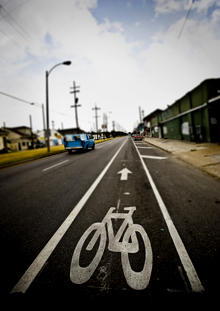Bike Lanes Bring a Lot More Riders
Are the freshly striped bicycle lanes on many New Orleans streets enticing more people to ride their bikes? A new Tulane University study sees a big increase in cycling along St. Claude Avenue, the city's first street to get the new lanes.

Bicycle traffic is rising in the new bicycle lanes on St. Claude Avenue, according to a study by the Prevention Research Center at Tulane. (Photo by Paula Burch-Celentano)
Observers found a 57 percent increase in the average number of riders per day during a two-week period in November 2008 just six months after the lanes were installed compared to a study period in the same month a year earlier when no lanes existed.
The research article, which is published in the latest issue of the Journal of Physical Activity and Health, is one of the few to examine cycling for an extended time period before and after lane installation, says lead author Kathryn Parker. The co-authors are associate professors Jeanette Gustat and Janet Rice.
“These findings suggest that bike lanes are well-suited to New Orleans,” said Parker, assistant director of Tulane's Prevention Research Center in the School of Public Health and Tropical Medicine. “Installing bike lanes is a cost-effective means of encouraging residents to be physically active for transportation and recreation.”
Observers counted cyclists in a designated area along Saint Claude from Elysian Fields to Franklin Avenue for nine hours daily. Average ridership increased to almost 143 cyclists per day compared to 91 before the lane installation.
To make sure the increase could be credited to the new lanes, authors discounted other factors that could have increased cycling fuel costs and population increases. Average gasoline prices fell by almost $1 during the two study periods, while census estimates showed only a 17 percent increase in population for nearby neighborhoods during the year.
The new lanes had the biggest statistical impact on female cyclists, increasing the average daily number of women riding by 133 percent compared to a year earlier. Prior studies have shown that women prefer biking areas that are separated from traffic.
